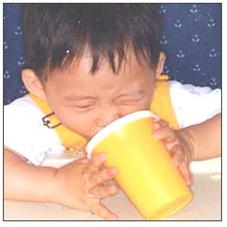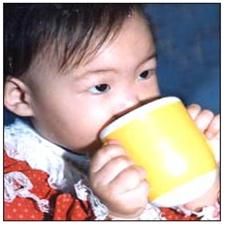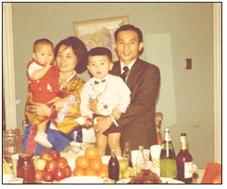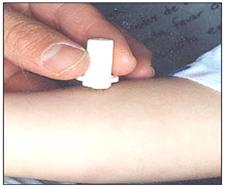생후 10∼12개월 영아를 위한 모유수유, 인공영양, 이유식, Breastfeeding, formula feeding, and solid food feeding for 8~9 months infants file
표 3-4.생후 10개월 된 한국 영아들의 체중과 신장의 백분위수
| 성별
백분위 수 |
3 | 10 | 25 | 50 | 75 | 90 | 97 | |
| 남아 | 체중(kg) | 7.03 | 7.80 | 8.30 | 9.00 | 9.60 | 10.40 | 11.41 |
| 신장(cm) | 67.2 | 69.0 | 70.6 | 72.4 | 75.0 | 77.0 | 80.4 | |
| 여아 | 체중(kg) | 6.75 | 7.40 | 8.00 | 8.50 | 9.20 | 10.0 | 11.00 |
| 신장(cm) | 66.2 | 68.2 | 70.0 | 71.4 | 74.0 | 76.4 | 84.2 |
표 3-5.11개월 한국 영아들의 체중과 신장의 백분위수
| 성별
백분위 수 |
3 | 10 | 25 | 50 | 75 | 90 | 97 | |
| 남아 | 체중(kg) | 7.15 | 8.00 | 8.55 | 9.30 | 10.00 | 10.50 | 11.80 |
| 신장(cm) | 67.6 | 70.2 | 72.1 | 74.2 | 76.3 | 81.0 | 85.0 | |
| 여아 | 체중(kg) | 6.90 | 7.45 | 8.05 | 8.85 | 9.50 | 10.20 | 11.60 |
| 신장(cm) | 66.6 | 68.4 | 70.5 | 72.5 | 75.0 | 78.4 | 85.00 |
|
생후 10∼12개월 영아를 위한 모유수유 |
- 첫 돌까지 또는 돌 이후부터 몇 개월까지 모유수유를 계속 해도 된다.
- 하루 3번 정도 모유수유를 할 수 있다.
- 첯 돌 이후 모유만 먹으면 유아가 필요로 하는 영양분과 에너지를 충분히 섭취할 수 없다.
- 모유를 먹는 아기에게 엄마아빠가 먹는 밥상 음식물을 먹이고 모유도 먹이고 인공영양, 이유식을 균형 잡히게 충분히 먹일 수 있다.
- 첫 돌까지 또는 첫 돌 이후 몇 달 동안 모유 이 외 다른 음식물을 균형 잡히게 잘 먹는 아기에게 모유수유를 계속해도 좋으나 생후10~12개월 영아에는 모유수유를 더 이상하지 안 해도 된다,
| 생후 10∼12개월 영아를 위한 인공영양 |
이유식과 식구들이 먹는 밥상 음식물을 잘 먹고 소화를 잘 시키면 하루 3번 정도 첫 돌까지 인공영양을 먹여도 좋다.

사진 4-37. 이유 연습용 컵으로 물, 액체, 이유식을 스스로 마실 수 있다.
Copyright ⓒ 2011 John Sangwon Lee, MD., FAAP

사진 4-38. 이유 연습용 컵으로 이유식을 마신다.
Copyright ⓒ 2011 John Sangwon Lee, MD., FAAP

사진 4-39. 자녀에게 생일잔치를 꼭 해준다. 자녀들의 생일을 축하하는 생일잔치를 해주면 부모가 나에게 집중적 관심을 갖고 나를 특별히 보살피고 사랑한다고 믿는다. 생일잔치는 집중적으로 사랑해 주는 방법 중 가장 좋은 방법 중 하나이다.
Copyright ⓒ 2011 John Sangwon Lee, MD., FAAP

사진 4-40. 생후 1년이 되었을 때 소아 정기 건강검진을 받고 결핵에 걸려있나 알아보기 위해 PPD나 타인 투베르쿨린 검사를 한다.
Copyright ⓒ 2011 John Sangwon Lee, MD., FAAP
| 생후 10∼12개월 영아를 위한 이유식 |
- 주니어 이유식을 사서 먹일 수도 있고, 엄마가 신선한 음식 재료로 주니어 이유식을 집에서 요리해 먹일 수 있다.
- 엄마 아빠가 먹는 밥상 음식물을 영유아가 먹기 좋게 요리해서 조심히 먹일 수 있다.
- 씹지 않고 넘길 수 없는 단단하고 질기고 큰 덩어리 음식물은 영유아에게 먹여서는 안 된다.
- 아기의 나이와 성장발육 성숙도에 따라 밥상 음식물을 잘 골라 조심히 먹여야 한다.
- 잘 씹어 먹을 수 있을 정도로 젖니가 많이 나 있지 않은 영유아에게 밥상 음식물을 먹일 때는 먹기에 적합하게 요리해서 먹여야 한다.
- 1일 3회 주식을 먹이고 주식과 주식 사이에 간식을 1일 3회 먹인다.
- 첫 돌 전, 영아들은 수저나 손으로 자기 스스로 먹기를 좋아한다.
- 바닥이나 밥상이 흘린 음식물로 지저분해지고 손 얼굴 등에 음식물을 묻히는 것이 보통이다.
- 주스, 물, 또는 그 외 음료수는 우유병으로 먹이지 말고 이유 연습용 컵이나 보통 컵으로 먹인다. 이유식을 수저나 손으로 먹게 한다.
- 인공영양이나 주스 이유식이나 액체 이유식을 넣은 젖병을 빠르면서 재우면 충치가 생기기 쉽고 중이염 또는 축농증에 걸리기 쉽다.
- 이 때 영아가 특히 좋아하고 먹기 좋아하는 음식물과 먹기 싫어하는 음식물을 확실히 알아내어 분별 있게 먹인다. 그 아기가 좋아하는 음식물을 골라 먹을 수 있다.
- 어떤 이유식에 음식물 불내성이 있거나 알레르기가 생길 수 있다. 그 때문에 영유아가 먹기 싫어하는 음식물도 있다.
- 탄수화물 류, 지방질 류, 단백질 류, 비타민제, 미네랄, 수분 등 각종 영양분이 골고루 들어 있는 균형 잡힌 음식물을 충분히 골고루 매일 잘 먹여야 한다.
- 야채류 이유식보다 과일류 이유식을 더 좋아하면 과일류 이유식을, 단백질 류 이유식으로 닭고기 이유식보다 쇠고기 이유식을 더 좋아하면 쇠고기 이유식을, 탄수화물 류 이유식으로 감자 이유식보다 쌀 이유식을 더 좋아하면 쌀 이유식을 먹이는 식으로 탄수화물 류. 단백질 류, 채소류와 과일류 등 주 필수 영양가 음식물을 균형 잡히게 골고루 먹인다.
Breastfeeding, formula feeding, and solid food feeding for 8~9 months infants
생후 10∼12개월 영아를 위한 모유수유, 인공영양, 이유식
Table 3-4. Percentiles of weight and height of Korean infants aged 10 months after birth
| Gender /Percentile | 3 | 10 | 25 | 50 | 75 | 90 | 97 | |
| Boys | weight(kg) | 7.03 | 7.80 | 8.30 | 9.00 | 9.60 | 10.40 | 11.41 |
| Height(cm) | 67.2 | 69.0 | 70.6 | 72.4 | 75.0 | 77.0 | 80.4 | |
| Girls | weight(kg) | 6.75 | 7.40 | 8.00 | 8.50 | 9.20 | 10.0 | 11.00 |
| Height(cm) | 66.2 | 68.2 | 70.0 | 71.4 | 74.0 | 76.4 | 84.2 |
표 3-5.11개월 한국 영아들의 체중과 신장의 백분위수
| Gender /Percentile | 3 | 10 | 25 | 50 | 75 | 90 | 97 | |
| Boys | weight(kg) | 7.15 | 8.00 | 8.55 | 9.30 | 10.00 | 10.50 | 11.80 |
| Height(cm) | 67.6 | 70.2 | 72.1 | 74.2 | 76.3 | 81.0 | 85.0 | |
| Girls | weight(kg) | 6.90 | 7.45 | 8.05 | 8.85 | 9.50 | 10.20 | 11.60 |
| Height(cm) | 66.6 | 68.4 | 70.5 | 72.5 | 75.0 | 78.4 | 85.00 |
|
Breastfeeding for infants 10-12 months old |
You can continue breastfeeding until the first birthday or for several months after the birth. You can breastfeed about 3 times a day.
If he eats only breast milk after his first birthday, he will not be able to get enough nutrients and energy that infants need.
It is possible to feed breastfeeding babies with meals at the table that mothers and dads eat, breastfeeding, artificial nutrition, and feeding enough to balance baby food.
It is okay to continue breastfeeding a baby until the first birthday or for several months after the first birthday, and to a baby who eats other foods in a well-balanced manner, but it is not necessary to continue breastfeeding for infants of 10-12 months of age.
Artificial nutrition for infants 10-12 months old If you eat well the baby food and the food that your family eats and digest well, you can feed artificial nutrients up to the first birthday three times a day.

Photo 4-37. Weaning.
He can drink water, liquids, and baby food on his own with this practice cup. Copyright ⓒ 2011 John Sangwon Lee, MD., FAAP

Photo 4-38. Drink baby food with a training cup. Copyright ⓒ 2011 John Sangwon Lee, MD., FAAP

Photo 4-39. Make sure to give your child a birthday party. I believe that if you hold a birthday party to celebrate your children’s birthday, your parents will pay attention to me and take special care of me and love me. A birthday party is one of the best ways to focused attention love. Copyright ⓒ 2011 John Sangwon Lee, MD., FAAP

Photo 4-40. At the age of 1 year, children undergo regular health check-ups, and PPD or other tuberculin tests are done to see if they have tuberculosis. Copyright ⓒ 2011 John Sangwon Lee, MD., FAAP
Baby food for infants 10-12 months old
You can buy and feed junior baby food, or his mom can cook and feed junior baby food at home with fresh ingredients.
You can cook the meals that mom and dad eat to make it easier for infants to eat and feed them carefully. Hard, tough, large chunks of food that cannot be passed over without chewing should not be fed to infants.
According to the baby’s age and maturity of growth and development, it is necessary to carefully select the food for the meal and feed it carefully.
When feeding meals to infants who do not have a lot of teething enough to chew and eat, they should be cooked and fed appropriately for eating.
Feed the meals 3 times a day and snacks between the meals and the meal 3 times a day. Before the first birthday, infants like to eat themselves with a spoon or hand. It is common for the floor or table to become messy with spilled food and to get food on the hands and face.
Do not feed juice, water, or other beverages with a milk bottle, but with a weaning cup or regular cup. Have baby food eaten with a spoon or hands.
If you put a baby bottle containing artificial nutrition or juice food or liquid baby food to sleep quickly, it is easy to cause tooth decay, and it is easy to get otitis media or sinusitis. At this time, make sure that the foods that infants particularly like and don’t like to eat are identified and fed sensibly.
You can choose the food which the baby likes and eat it. Certain baby foods may have food intolerance or allergies.
Because of that, there are some foods that infants and toddlers do not like to eat. They need to eat well-balanced foods that contain various nutrients such as carbohydrates, fats, proteins, vitamins, minerals, moisture, etc., evenly and well every day.
If he prefers fruit-based baby food to vegetable baby food, he can eat fruit baby food, beef baby food if he likes beef baby food more than chicken baby food for protein type, and rice baby food if he likes rice baby food more than potato baby food for carbohydrate type baby food like carbohydrates. You feed foods with essential nutrients such as proteins, fat, carbohydrate, minerals, vitamins, vegetables, and fruits in a balanced manner.
출처 및 참조 문헌
- NelsonTextbook of Pediatrics 22ND Ed
- The Harriet Lane Handbook 22ND Ed
- Growth and development of the children
- Red Book 32nd Ed 2021-2024
- www.drleepediatrics.com 제1권 소아청소년 응급 의료
- www.drleepediatrics.com 제2권 소아청소년 예방
- www.drleepediatrics.com 제3권 소아청소년 성장 발육 육아
- www.drleepediatrics.com 제4권 모유,모유수유, 이유
- www.drleepediatrics.com 제5권 인공영양, 우유, 이유식, 비타민, 미네랄, 단백질, 탄수화물, 지방
- www.drleepediatrics.com 제6권 신생아 성장 발육 육아 질병
- www.drleepediatrics.com제7권 소아청소년 감염병
- www.drleepediatrics.com제8권 소아청소년 호흡기 질환
- www.drleepediatrics.com제9권 소아청소년 소화기 질환
- www.drleepediatrics.com제10권. 소아청소년 신장 비뇨 생식기 질환
- www.drleepediatrics.com제11권. 소아청소년 심장 혈관계 질환
- www.drleepediatrics.com제12권. 소아청소년 신경 정신 질환, 행동 수면 문제
- www.drleepediatrics.com제13권. 소아청소년 혈액, 림프, 종양 질환
- www.drleepediatrics.com제14권. 소아청소년 내분비, 유전, 염색체, 대사, 희귀병
- www.drleepediatrics.com제15권. 소아청소년 알레르기, 자가 면역질환
- www.drleepediatrics.com제16권. 소아청소년 정형외과 질환
- www.drleepediatrics.com제17권. 소아청소년 피부 질환
- www.drleepediatrics.com제18권. 소아청소년 이비인후(귀 코 인두 후두) 질환
- www.drleepediatrics.com제19권. 소아청소년 안과 (눈)질환
- www.drleepediatrics.com 제20권 소아청소년 이 (치아)질환
- www.drleepediatrics.com 제21권 소아청소년 가정 학교 간호
- www.drleepediatrics.com 제22권 아들 딸 이렇게 사랑해 키우세요
- www.drleepediatrics.com 제23권 사춘기 아이들의 성장 발육 질병
- www.drleepediatrics.com 제24권 소아청소년 성교육
- www.drleepediatrics.com 제25권 임신, 분만, 출산, 신생아 돌보기
- Red book 29th-31st edition 2021
- Nelson Text Book of Pediatrics 19th- 21st Edition
- The Johns Hopkins Hospital, The Harriet Lane Handbook, 22nd edition
- 응급환자관리 정담미디어
-
소아가정간호백과–부모도 반의사가 되어야 한다, 이상원
-
Neonatal Resuscitation American heart Association
-
Neonatology Jeffrey J.Pomerance, C. Joan Richardson
-
Pediatric Resuscitation Pediatric Clinics of North America, Stephen M. Schexnayder, M.D.
-
Pediatric Critical Care, Pediatric Clinics of North America, James P. Orlowski, M.D.
-
Preparation for Birth. Beverly Savage and Dianna Smith
-
Infectious disease of children, Saul Krugman, Samuel L Katz, Ann A. Gershon, Catherine Wilfert
- Pediatric Nutritional Handbook American Academy of Pediatrics
- 소아가정간호백과–부모도 반의사가 되어야 한다, 이상원
- The pregnancy Bible. By Joan stone, MD. Keith Eddleman, MD
- Neonatology Jeffrey J. Pomerance, C. Joan Richardson
- Preparation for Birth. Beverly Savage and Dianna Smith
- 임신에서 신생아 돌보기까지. 이상원
- Breastfeeding by Ruth Lawrence and Robert Lawrence
- Infectious disease of children, Saul Krugman, Samuel L Katz, Ann A. Gershon, Catherine Wilfert
- The Harriet Lane Handbook 19th Edition
- 제4권 모유, 모유수유, 이유 참조문헌 및 출처
- 제5권 인공영양, 우유, 이유, 비타민, 단백질, 지방 탄수 화물 참조문헌 및 출처
- 제6권 신생아 성장발육 양호 질병 참조문헌 및 출처
- 소아과학 대한교과서
- 그 외
|
Copyright ⓒ 2015 John Sangwon Lee, MD, FAAP 미국 소아과 전문의, 한국 소아청소년과 전문의 이상원 저 “부모도 반의사가 되어야 한다”-내용은 여러분들의 의사로부터 얻은 정보와 진료를 대신할 수 없습니다. “The information contained in this publication should not be used as a substitute for the medical care and advice of your doctor. There may be variations in treatment that your doctor may recommend based on individual facts and circumstances. “Parental education is the best medicine.” |